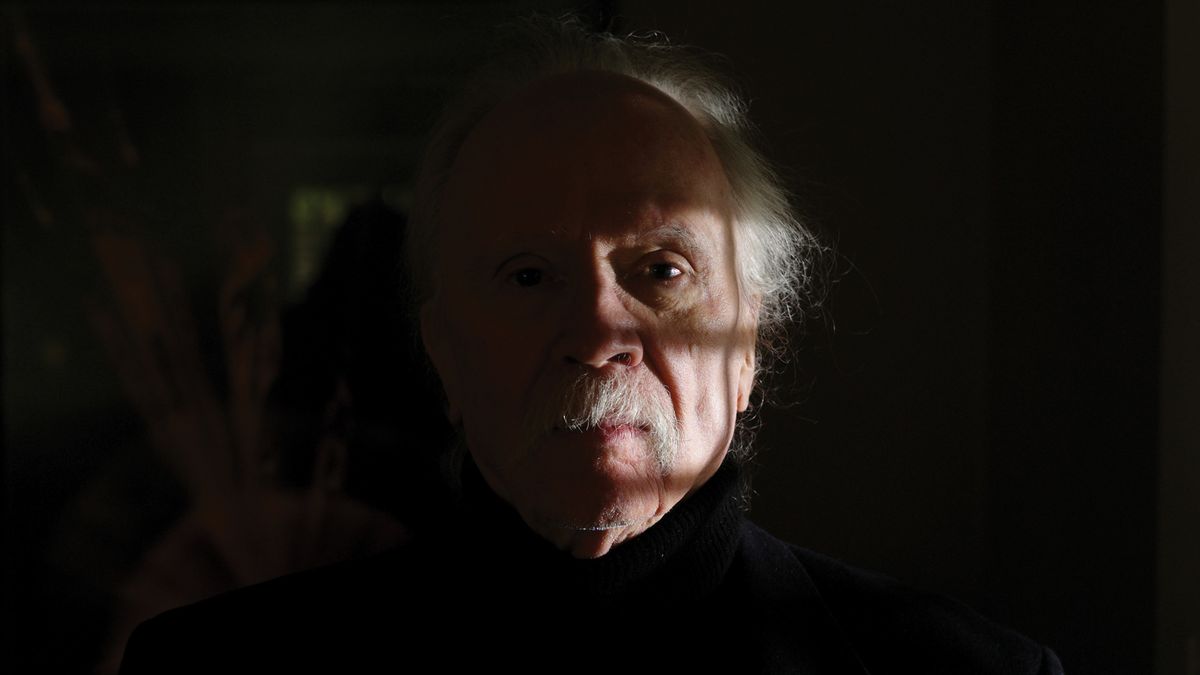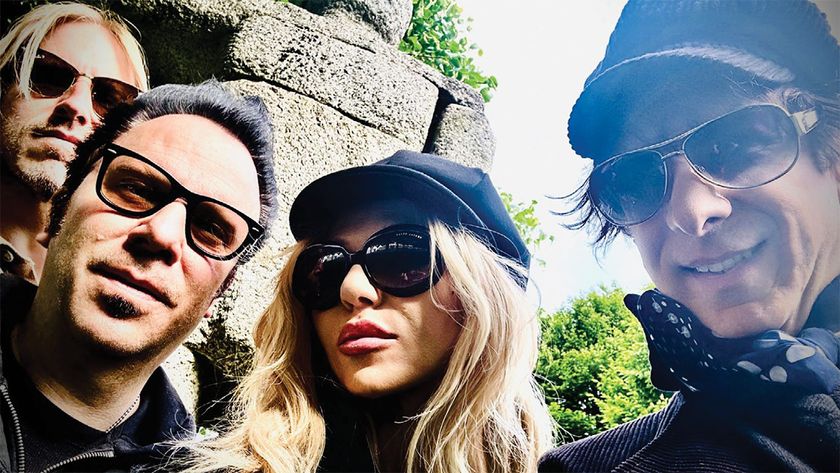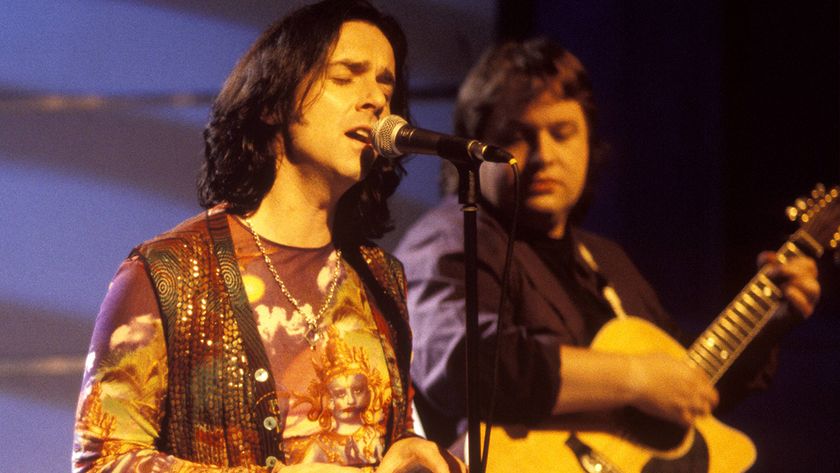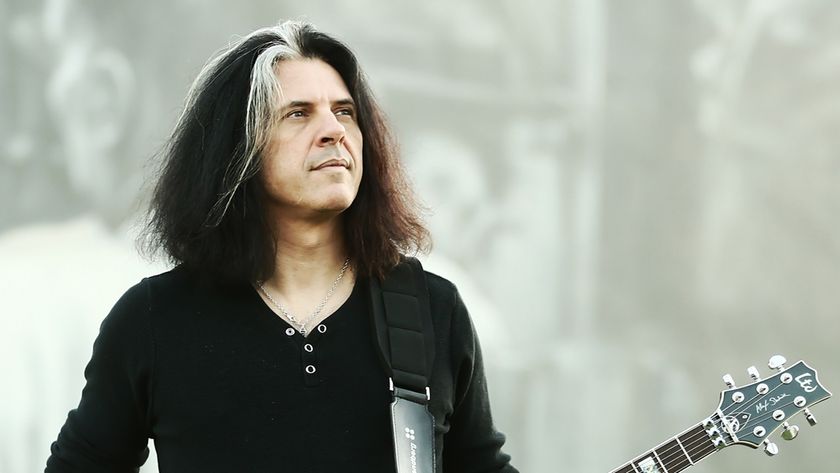John Carpenter secured immortality via a string of cult movies including Halloween, Dark Star, Escape From New York and The Thing. At the beginning of his career he wrote his soundtracks out of necessity. Then he created the Lost Themes album series, which saw him creating music for fun with his son and godson. In 2016 Carpenter told Prog about Lost Themes II and how he’d managed to build a second career in his 60s.
John Carpenter’s reputation was sealed with the series of films he made in the 70s and early 80s. Filmed on a budget of $300,000, 1978’s Halloween became one of the biggest indie hits in history, grossing $70m worldwide and more or less inventing the slasher genre. The Fog, The Thing and Christine may have been less successful at the box office, but they remain cult classics.
Carpenter’s other great area of excellence is sci-fi, his visions of a bleak, dystopian future tempered by a sly wit in movies like Dark Star (1974), Escape From New York (1981), Ghosts Of Mars (2001) and 1988’s satirical swipe at the mass media, They Live.
Yet he’s far more than just a writer-director. His self-composed soundtracks have always been a key component of his work. Inspired by his violinist father, a music teacher at Western Kentucky University who was also an in-demand session player, Carpenter began scoring his own shorts while studying cinema at the University Of Southern California in the late 60s. Hallucinatory western The Resurrection Of Broncho Billy – on which he was writer, editor and composer – won an Oscar in 1970 for Best Short Subject. A year later, he began work on Dark Star with classmate Dan O’Bannon (who would go on to write the screenplay for Alien). When it came to making the film, Carpenter shaped an electronic score on a VCS3 synthesiser.
The music for 1976 thriller Assault On Precinct 13 was suitably menacing and lean, then Carpenter achieved maximum effect from the most minimal of tools on his follow-up, Halloween. Its title theme is one of the most memorable motifs in modern cinema, created using just three notes. The inspiration, says Carpenter, was a 5/4 bongo rhythm his father had taught him as a 13-year-old. The rest of the soundtrack was suffused with a similar sense of impending dread.
The experience taught Carpenter a valuable lesson. “I screened the final cut, minus sound effects and music, for a young executive from 20th Century Fox,” he recalled. “She wasn’t scared at all. I became determined to save it with the music.” Having added the score, he ran into her again six months later: “Now she too loved the movie and all I’d done was add music.”
As fellow filmmaker Guillermo Del Toro has observed: “Carpenter’s scores fluctuate with his films. Listen to them – they embody the spirit of each film perfectly. They are his final auteur voice.”
It should come as no great surprise, then, to discover that Carpenter has been making non-soundtrack albums of late. Now aged 68, this year saw the release of Lost Themes II, the sequel to 2015’s Lost Themes, both of which are instrumental collaborations with his son Cody and his godson Daniel Davies.
Every person has a movie running in their head and this is the soundtrack for it
Lost Themes II is expansive and organic, driven by Carpenter’s eerie synth riffs and embellished with acoustic and electric guitars. Foreboding techno, dark blues and avant-garde ruminations are rolled out onto a prog landscape shaded by Tangerine Dream, Cluster and Carpenter’s own back catalogue.
The acclaim has been such that Carpenter and a five-piece band, including Cody and Davies, recently made their live debut in Europe, before heading off to America to tour. Reviews have bordered on the ecstatic, with Carpenter and co playing selections from his most iconic films, with accompanying clips on a backdrop, alongside choice selections from both Lost Themes albums.
He’s also just reissued the themes from Halloween, Escape From New York, Assault On Precinct 13 and The Fog on spanking new vinyl.
How did Lost Themes II develop?
We decided to do another record, and this time around, Cody and Daniel and I were all in the same town at the same time. The first Lost Themes album was done over a period of years. We would record some stuff, then Cody went off to Japan to teach English. So when we got the record deal, Daniel helped me finish it up, while Cody would send sketches over from the Far East via computer.
When it came to this one though, all three of us being in the same town together meant it was a much more immediate experience. That said, the idea is basically the same – every person has a movie running in their head and this is the soundtrack for it. We all brought sketches of ideas and our own stuff into it, so it was a real collaborative effort.
Lost Themes II sounds heavier and more organic than its predecessor…
Look, we’re naturally rocky people! It just sort of worked out that way.
Some of the titles alone are intriguing: Persia Rising, Angel’s Asylum, White Pulse – and not forgetting Windy Death…
[Laughing] That’s Cody’s. I decided on the names of these songs, incidentally, much to his chagrin. I don’t know if you’ve noticed, but the titles on Lost Themes were all one word. The titles on Lost Themes II are all two words. We’ll have to see if there’s a Lost Themes III and how they’ll work out.
To have a second career, at my time of life, is like, “Are you kidding me? Wow!”
Tell me about Bela Lugosi, another great piece…
That’s essentially Daniel’s inspiration. Daniel provided the impetus for the song Night, from the first album, which is very similar. He has a very unique approach and I just love to come along and play with him.
Dark Blues is a standout from Lost Themes II. How did that come together?
That was all based on hearing this arpeggiator on the synth [an arpeggiator creates a pattern from ‘listening’ to notes being played]. I thought, “Wow! Listen to that!” We started working with it, but the problem was that the arpeggiator was playing in triplets, so we all got screwed up. But we finally made it sound good.
I love the blues; I love that kind of feel. Daniel brought his incredible skills as a lead guitarist there. He knew exactly what to do. Then there’s a song like Distant Dream. I always wanted to do something that kicks ass and it’s partly a homage to Tangerine Dream. If you listen closely you can hear a little of Sorcerer [1977] creeping in there.
Were you ever tempted, at any point during the album sessions, to add a vocal?
No. This is all music for soundtracks, the brain’s soundtrack. The idea is to turn the lights off in your place of residence, sit down, put the music on, close your eyes and start to have a waking dream. And let the music be the soundtrack. It might even inspire people to create movies that could be scored with this music.
We had such a blast making this album. It was all about enjoying ourselves and having fun. And I don’t have to go through the bullshit of making movies. There were no pressures, no actors or crew asking what they’re supposed to do. And no cutting room to deal with.
The idea was to make my music fuller, because we had unlimited tracks to play around with. We just wanted to make it sound moody. And to have a second career, at my time of life, is like, “Are you kidding me? Wow!”
I listened to Procol Harum big time. And The Beatles of course… music was my first immediate love
That raises the question: why didn’t you do this earlier?
I never thought about it. And no one ever asked me, that’s the big thing. But I got a new music attorney and she asked me if I had anything new. I said, “Here, listen to this,” and played her the stuff I’d been doing with Cody. And all of a sudden I had a record deal. It just came out of nowhere.
Given that Lost Themes was one of the biggest sellers in Sacred Bones Records’ history, was it a no-brainer that there would be a follow-up?
No, not at all. I had to ask them: “Do you guys want another one?” The people at the label are so supportive of the kind of stuff we’re doing. We discuss many things and, of course, they have input into what gets released.
Going back to your formative years, your dad was a classical violinist, music teacher and session musician. So was music a huge part of your childhood?
Oh yeah. And I used to go with him to these sessions. You have no idea what it was like to be sitting there and seeing Roy Orbison. It was unbelievable. He would wear sunglasses all the time and had a guy who’d sing harmony with him, who also wore sunglasses. My dad played on one of Orbison’s biggest hits, In Dreams. I never met Patsy Cline, but I did meet Brenda Lee. My dad played with her on I’m Sorry. He also recorded with [pianist] Floyd Cramer and a whole lot of other people.
You grew up listening to classical music, but also to The Doors, the Stones and Procol Harum…
I listened to Procol Harum big time. And The Beatles of course. I loved music – it was my first immediate love. But my true calling was cinema. I fell in love with movies.
You were in a rock’n’roll band in high school, called Kaleidoscope. Did you want to be a musician?
Sure. I grew up in a little town in Kentucky [Bowling Green] during the 50s and put together a little band with friends. We’d play at fraternity parties and I’d be on electric bass or guitar. We’d be doing our set, watching these fraternity members get completely drunk and trying to grope their girlfriends. It was fun; we made some money. But I came to a crossroads in my life where I thought, “What the hell am I going to do? I can’t just keep on doing this.” That’s when I went off to California to learn how to make movies.
When did you first come across the music of one of your big influences, Bernard Herrmann?
The Day The Earth Stood Still [1951] was the big one for me. The music was scary, as a kid. I wish the movie had been a little scarier, but Herrmann’s music was like, “Wow!” And then Vertigo, North By Northwest and, of course, Psycho. I grew up watching all those great Hitchcock movies he made soundtracks for.
Dave Davies’ music was haunting and dark and heroic. I loved it
Herrmann created emotionally charged scores that were also very minimal…
That was the main reason why I was so drawn to Bernard Herrmann. It gave me hope as a composer. My lot was all-functional. When you’re a student filmmaker, or a low-budget filmmaker, you have no money to hire a composer or an orchestra, so I had to do it myself. I was cheap and I was fast, so that’s why I did it.
Bernard Herrmann was inspirational because he got maximum effects from real simple means and simple chord progressions. He had this ability to create a powerful score using only limited orchestra means, using basic sounds like high strings or low bass. Psycho, which was a big inspiration for Halloween, mostly just used string instruments for its soundtrack. So I thought to myself, “Hell, I’m no goo,d really – I can’t play very well, but maybe I can make my way through this with a synthesiser.” That’s how it all started.
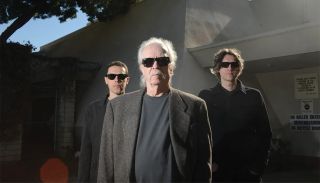
So you started composing music for film through necessity?
Exactly. There was no other choice.
How much of an influence on you was Dimitri Tiomkin as a composer?
He was huge for me – a giant. He was so much more accomplished, musically, than I am, so I could never really get to where he was. But he was just such an amazing composer.
There are modern-day composers I admire too. I’m very big on Hans Zimmer, for instance. He has to be my favourite. Like some of the great masters, his stuff is really memorable and transformative. And I also like some of the stuff that Trent Reznor has done.
You’ve been associated with rock musicians too. You’re good friends with Dave Davies, with whom you worked on your 1995 remake of Village Of The Damned…
I was always a big Kinks fan and it was really fun to get together for that movie. Dave sent me a cassette of a musical idea that guided the direction for the soundtrack of Village Of The Damned. Dave’s music was haunting and dark and heroic. I loved it. We worked with the Robb Brothers at Cherokee Studios in Los Angeles and ended up with a score that combined live instruments with synthesisers. When our compositions came out of the speakers, they’d been transformed into one of the most romantic scores I’ve ever done.
The music from Forbidden Planet takes me back to an innocent time when I believed there was an invisible monster stalking me
I love working with other musicians. Musicians have a whole different vibe to movie people, it’s just a whole different ball game. It’s hard to put my finger on exactly what it is, but they’re snobs in a different way. Let’s just put it like that.
What was the first synthesiser score that grabbed you?
There was only one, and that was Forbidden Planet [1956]. I was eight years old when I first saw that movie and the soundtrack was different to everything else I’d ever heard. I knew it was created on a synthesiser – though I didn’t know what that meant exactly – and that it was electronic music.
The Barrons [Bebe and Louis], the husband and wife team who composed it, did it with relays and all sorts of methods that seem crude by today’s standards. But man, the impact of that was just unbelievable. I still appreciate that music now – it gives me chills whenever I hear it. And it takes me back to an innocent time when I believed there was an invisible monster stalking me.
Your synthesiser scores of the 70s – Dark Star, Assault On Precinct 13, Halloween – were strikingly different to most other film soundtracks of the time, which were often orchestral or rooted in jazz and funk. Yours seemed futuristic by comparison.
Yeah, that’s true. I remember we had two weeks to do the scoring sessions for Halloween, because that’s all the budget would allow. There was some other great stuff around in the 70s too though, like Tangerine Dream. Sorcerer is a very underrated movie, with an incredible score. It still sounds like nothing else I’ve heard. And some of Dario Argento’s early Italian movies introduced me to the work of Goblin, whose music was just incredible on Suspiria [1977]. Have you ever heard that soundtrack? It’s unbelievable. So there was other unusual stuff being done in various places.
When it came to doing soundtracks, sometimes I’d have a basic theme or a sketch, something I’d put together and started working on at home, but mostly it was all improvisation.
I told Ennio to come up with something very simple… something that even I could play
Talking of Goblin and Tangerine Dream, were you ever a fan of progressive music?
I’m still not quite sure exactly what it is, but my son Cody is a huge fan of progressive music. He loves it. And, of course, he is Ludrium, which is a progressive rock act.
Did the Suspiria soundtrack feed into Halloween?
Of course. But there was also Ennio Morricone’s work on those Italian films. He was an experimental composer and some of the sounds that he created were groundbreaking. His music was so memorable and so attached to the images on screen. And so moving, especially when you consider the score for Once Upon A Time In The West [1968]. You can’t get better than that. It’s triumphant.
You finally got the chance to work with Morricone on 1982’s The Thing. Bearing in mind he doesn’t speak any English, how did you manage to communicate?
Not very well! Not speaking the same language meant that we had to use interpreters. He was a very kind and compassionate man. A wonderful man. The main collaboration we did was working on the main title for The Thing. I just told him to come up with something very simple, because he was composing general pieces that were very involved. But I wanted something basic, something that even I could play. So that’s what he did. In fact, we’ve been playing that at the live shows.
Was there much trepidation about making your live debut as a performing musician earlier this year?
Of course. I was scared to death! But it’s been a blast so far. I get up there, this old man walking out on stage. I have a rock’n’roll band, because a lot of my scores are rock’n’roll-based. And of course I have Cody and Daniel with me. But we play a lot of themes from my movies and also a lot of songs from the two albums, Lost Themes I and II. There’s visuals too, so it’s an entertaining evening for all, hopefully.
Do you plan to keep on making music and playing more live dates now?
This whole thing came about after Cody and Daniel convinced me to do it. They said to me, “Well, how great would it be to tour with us?” I said, “You know what? You’re right.” So the honest answer is: I don’t know. We’ll just have to see how it goes and take it from there. People haven’t booed me yet when I’ve stepped out onto the stage, which is always a good sign.
